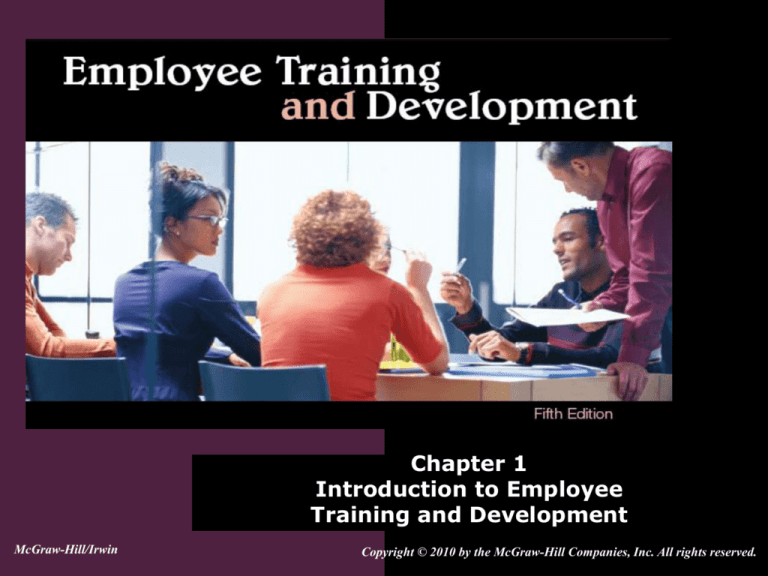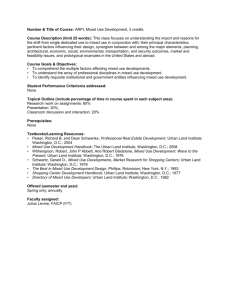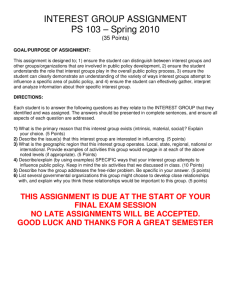
Chapter 1
Introduction to Employee
Training and Development
McGraw-Hill/Irwin
Copyright © 2010 by the McGraw-Hill Companies, Inc. All rights reserved.
What is Training?
Training - a planned effort by a
company to facilitate employees’ learning
of job-related competencies.
Competencies include knowledge, skills or
behavior critical for successful job
performance.
The goal of training is for employees to
master the competencies and apply them
to their day-to-day activities.
1-2
What is Training? (cont.)
To use training to gain a competitive
advantage, a company should view
training broadly as a way to create
intellectual capital.
Intellectual capital includes basic skills
advanced skills an understanding of the
customer or manufacturing system, and
self-motivated creativity.
1-3
What is Training? (cont.)
High-leverage training
Is linked to strategic business goals and
objectives.
Uses an instructional design process to ensure
that training is effective.
Compares or benchmarks the company's
training programs against training programs
in other companies.
Creates working conditions that encourage
continuous learning.
1-4
What is Training? (cont.)
Continuous learning - requires
employees to understand the entire work
system, including the relationships
among their jobs, their work units, and
the company.
1-5
What is Training? (cont.)
Managers take an active role in:
Identifying training needs.
Ensuring that employees use training in their
work.
Facilitating the sharing of knowledge, by
using informational maps.
1-6
What is Training? (cont.)
Today, training is being evaluated on how
training addresses business needs related
to learning, behavior change, and
performance improvement.
1-7
What is Training? (cont.)
There is a greater emphasis on:
Providing educational opportunities for all
employees.
Performance improvement as an ongoing
process than a one-time training event.
Demonstrating to executives, managers, and
trainees the benefits of training.
Learning as a lifelong event.
Training being used to help attain strategic
business objectives.
1-8
Designing Effective Training
Training design process
A systematic approach for developing training
programs.
Is based on the principles of Instructional
System Design (ISD).
Is sometimes referred to as the ADDIE model
because it includes analysis, design,
development, implementation, and
evaluation.
Should be systematic yet flexible enough to
adapt to business needs.
1-9
Figure 1.1 - Training Design
Process
1-10
Designing Effective Training
(cont.)
Regardless of the specific ISD approach
used, all the steps share the following
assumptions:
Training design is effective only if it helps
employees reach their training objectives.
Measurable learning objectives should be
identified before the training program begins.
Evaluation plays an important part in planning
and choosing a training method, monitoring
the training program, and suggesting changes
to the training design process.
1-11
Designing Effective Training
(cont.)
Flaws of the ISD model:
In organizations, the training design process
rarely follows the step by-step approach of
the activities.
Organizations require trainers to provide
detailed documents of each activity found in
the model; this adds time and cost to
developing a training program.
It implies an end point: evaluation.
1-12
Table 1.1 - Forces Influencing
Working and Learning
1-13
Forces Influencing Working and
Learning
Economic cycles
Provide an opportunity for companies to take
a closer look at training and development to
identify those activities that are critical for
supporting the business strategy as well as
those mandated by law.
1-14
Forces Influencing Working and
Learning (cont.)
Globalization
Provide training and development
opportunities for global employees.
Provide cross-cultural training to prepare
employees and their families to understand
the culture and norms of the country to which
they are being relocated and assists in their
return to their home country after the
assignment.
1-15
Table 1.2 - Examples of
Intangible Assets
1-16
Forces Influencing Working and
Learning (cont.)
The value of intangible assets and human
capital has the following implication:
Focus on knowledge worker - employees
who contribute to the company not through
manual labor but through what they know,
perhaps about customers or a specialized
body of knowledge.
1-17
Forces Influencing Working and
Learning (cont.)
The value of intangible assets and human
capital has the following implication:
Employee engagement - the degree to
which employees are fully involved in their
work and the strength of their commitment to
their job and the company.
Companies measure employees' engagement
levels with attitude or opinion surveys.
1-18
Forces Influencing Working and
Learning (cont.)
The value of intangible assets and human
capital has the following implication:
Change - the adoption of a new idea or
behavior by a company.
Learning organization - embraces a culture
of lifelong learning, enabling all employees to
continually acquire and share knowledge.
1-19
Table 1.3 - How Managing Cultural Diversity
can Provide Competitive Advantage
1-20
Forces Influencing Working and
Learning (cont.)
Talent management - attracting,
retaining, developing, and motivating
highly skilled employees and managers.
It is becoming increasingly more
important because of:
occupational and job changes.
retirement of baby boomers.
skill requirements.
the need to develop leadership skills.
1-21
Forces Influencing Working and
Learning (cont.)
Customer service and quality emphasis
Total Quality Management (TQM) - a
companywide effort to continuously improve
the ways people, machines, and systems
accomplish work.
1-22
Forces Influencing Working and
Learning (cont.)
Core values of TQM
Methods and processes are designed to meet
the needs of internal and external customers.
Every employee in the company receives
training in quality, which is designed into a
product or service to prevent errors from
occurring rather than being detected and
corrected.
1-23
Forces Influencing Working and
Learning (cont.)
Core values of TQM
The company promotes cooperation with
vendors, suppliers, and customers to improve
quality and hold down costs.
Managers measure progress with feedback
based on data.
1-24
Forces Influencing Working and
Learning (cont.)
Customer service and quality emphasis
The Malcolm Baldrige National Quality
Award , created by public law, is the highest
level of national recognition for quality that a
U.S. company can receive.
The ISO 9000 is a family of standards that
include requirements for dealing with how to
establish quality standards and how to
document work processes to help companies
understand quality system requirements.
1-25
Table 1.5 - Categories and Point Value for the
Malcolm Baldrige National Quality Award
Examination
1-26
Forces Influencing Working and
Learning (cont.)
Customer service and quality emphasis
Six Sigma process - a process of measuring,
analyzing, improving, and then controlling
processes once they have been brought
within the narrow six sigma quality tolerances
or standards.
Training can help companies meet the quality
challenge by teaching employees statistical
process control and engaging in “lean”
processes.
1-27
Forces Influencing Working and
Learning (cont.)
Customer service and quality emphasis
Lean thinking - involves doing more with
less effort, equipment, space, and time, but
providing customers with what they need and
want.
ISO 10015 - a quality management tool
designed to ensure that training is linked to
company needs and performance.
1-28
Forces Influencing Working and
Learning (cont.)
New technology
Is changing the delivery of training and
makes training more realistic.
Allows training to occur at any time and any
place.
Reduces travel costs.
Provides greater accessibility to training and
consistent delivery.
1-29
Forces Influencing Working and
Learning (cont.)
Provides the ability to access experts and
share learning with others.
Provides the possibility of creating a learning
environment with many positive features such
as feedback, self-pacing, and practice
exercises.
Allows companies greater use of alternative
work arrangements.
1-30
Forces Influencing Working and
Learning (cont.)
High performance models of work
systems
Work teams - involve employees with
various skills who interact to assemble a
product or provide a service.
Cross training - training employees in a
wide range of skills so they can fill any of the
roles needed to be performed on the team.
1-31
Forces Influencing Working and
Learning (cont.)
High performance models of work
systems
Virtual teams - teams that are separated by
time, geographic distance, culture, and/or
organizational boundaries and that rely
almost exclusively on technology to interact
and complete their projects.
Use of new technology and work designs
are supported by human resource
management practices.
1-32
Snapshot of Training Practices
Key trends in learning initiative
investments:
Direct expenditures, as a percentage of
payroll and learning hours, have remained
stable over the last several years.
There is an increased demand for specialized
learning that includes professional or
industry-specific content.
The use of technology-based learning delivery
has increased from 11 percent in 2001 to 33
percent in 2007.
1-33
Snapshot of Training Practices
(cont.)
Self-paced online learning is the most
frequently used type of technology-based
learning.
Technology-based learning has helped
improve learning efficiency, and has resulted
in a larger employee–learning staff member
ratio.
The percentage of services distributed by
external providers dropped from 29 percent in
2004 to 25 percent in 2007.
1-34
Table 1.8 - Comparison of BEST Award
Winners and Benchmark Companies
1-35
Table 1.7 - Characteristics of
BEST Award Winners
1-36
Figure 1.4 - The 2004 ASTD
Competency Model
1-37
Snapshot of Training Practices
(cont.)
In most companies training and
development activities are provided by
trainers, managers, in-house consultants,
and employee experts.
They can also be outsourced.
Training and development can be the
responsibility of professionals in human
resources, human resource development,
or organizational development.
1-38
Snapshot of Training Practices
(cont.)
As companies grow and/or recognize the
important role of training for business
success, they form an entire training
function, which may include instructional
designers, instructors, technical training,
and experts in instructional technology.
To be a successful training professional
requires staying up-to-date on current
research and training practices.
1-39





